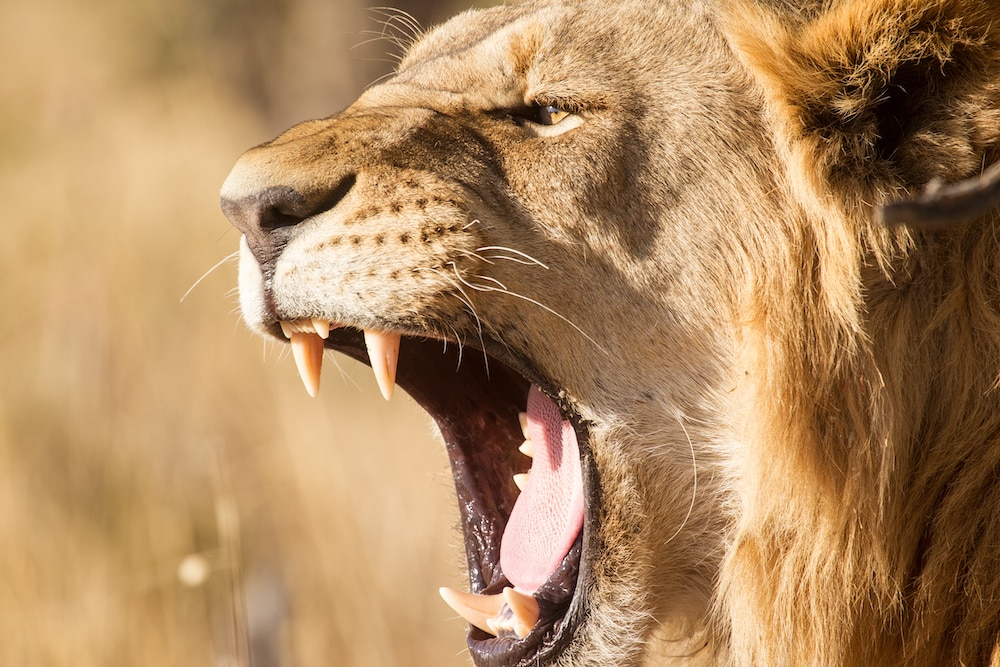Create a free profile to get unlimited access to exclusive videos, sweepstakes, and more!
Taming lions with a chemical love potion
Oxytocin nasal spray is the next best thing to a chill pill.

When you’re the king of the jungle you can do whatever you want, but what happens when your kingdom starts to shrink? That’s the challenge many lions are now facing. In the wild, human encroachment is shrinking natural habitats, and things are worse in captivity.
Lions are naturally social animals who live in big groups and develop strong bonds both with family members and complete strangers. Shrinking habitats eliminate or reduce the opportunity for lions to interact with one another as they normally would. That becomes a big problem when lions are rescued and reintroduced into larger groups.
Jessica Burkhart from the Department of Ecology, Evolution, & Behavior at the University of Minnesota was the lead author on a study published in the journal iScience, looking at the effects of oxytocin on the social behavior of lions.
“We see an increase in their social learning and social memory, but it doesn’t change their cognition, which is what’s really wonderful about it,” Burkhart told SYFY WIRE. “I kind of relate it to caffeine where it doesn’t change who you are or your personality, it just gives you an edge. Oxytocin is kind of the opposite. It takes the edge off.”
As humans move into areas which have traditionally been lion territory, groups of lions are being cut off from one another so that they can’t rotate in and out. This causes populations to stagnate and genetic diversity to decrease. Conservationists work to swap individuals from group to group, moving male lions out and bringing female lions in, artificially doing the work nature has done for so long.
“If there’s a new area we’re going to restore, we need to create a superficial lion pride. We’ll hand pick animals we want to put together, but that’s not natural,” Burkhart said.
While lions are social creatures, they’re also capable of violence toward one another when they’re feeling threatened, anxious, or territorial. To reduce the risk when introducing lions to a new group, conservationists will often leave them in enclosures for a few weeks before releasing them into the reserve area. Otherwise, they might keep a group of lions tranquilized in the same area together for weeks at a time, hoping they’ll become accustomed to one another. Burkhart said sometimes that works, but sometimes they fight or run in opposite directions.
The oxytocin study was an attempt to find an alternative solution which minimizes trauma to the animals while maximizing the likelihood they’ll form lasting bonds.
“Oxytocin decreases anxiety and fear and increases long-term potentiation in the prefrontal cortex, that means the connection of neurons. So, your fear center is decreased, and your reward center is activated. Instead of being afraid and hesitant, the social situation feels more rewarding,” Burkhart said.
When lions are moved from one location to another they’re anesthetized for the trip. Burkhart administered oxytocin intranasally, using a medical atomizer that looks a little like a vintage perfume bottle, in the moments before the lions come out of anesthesia. The result is they wake up calm, curious, and interested in who their neighbors are and what they’re doing. Because oxytocin impacts the learning center, even one dose is good enough to help build lasting bonds.
The effects of oxytocin appear to be rapid, quickly reducing aggression and fear in lions and other big cats. Researchers measured the effectiveness by observing how closely lions let others approach while playing with a desired object like a pumpkin toy.
“They’ll go from this wrinkled expression to being really calm. Their naturalistic behaviors increase, and their stress behaviors decrease,” Burkhart said.
While administering oxytocin has staggering effects on lions in social situations, the benefits extend to other big cat species who are less social. Cheetahs, in particular, are at risk during relocations, owing to a tendency to become stressed. Oxytocin has been shown to reduce the stress response and improve the likelihood of a successful relocation.
“Cheetah’s die really easily when they’re being translocated, from stress and fear. They go into renal failure. I’ve been asked to go and do cheetah relocations and it’s worked like a charm. Rather than panting and dying, they wake up super chill,” Burkhart said.
These negative responses in big cats are a result of human interference in their natural lives and oxytocin appears to essentially hack the brain such that they behave in ways which are closer to how they would if we hadn’t been involved at all.
If humans must continue to interfere with animal habitats, the least we can do is vanish in a puff of atomized love chemicals.


























